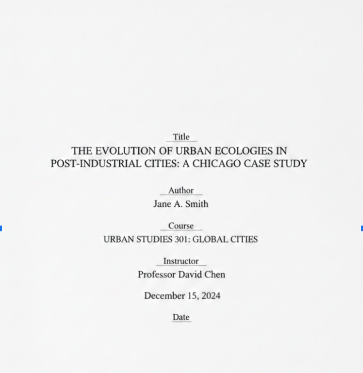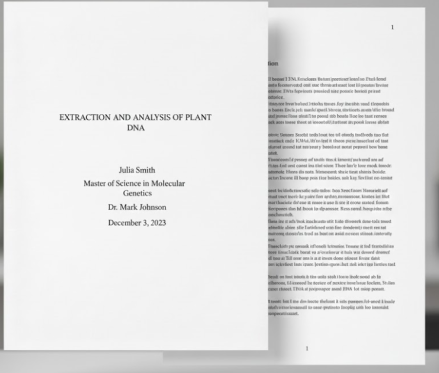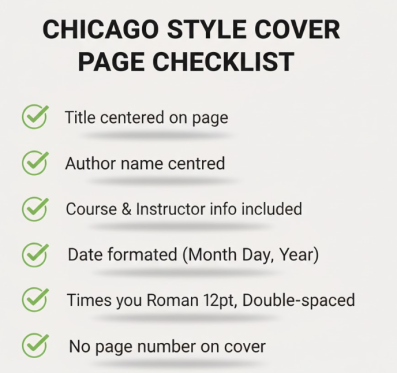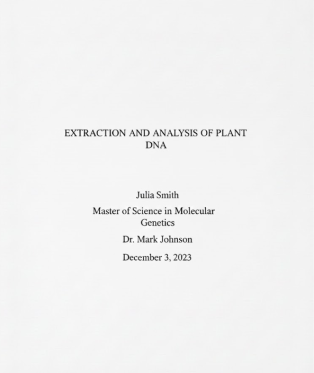Table of Contents
A well-formatted cover page is a crucial part of academic writing in Chicago style. It sets the tone for your paper, provides essential details about the author and course, and ensures consistency with the Chicago citation style guide. In this guide, we’ll explore the elements of a Chicago style title page, how to format it correctly, and practical examples you can model for your assignments or research papers.
A Chicago style cover page, also known as a title page, is the first page of a research paper or essay following the Chicago Manual of Style (CMS) or its student-oriented variant, Turabian. While the Chicago Manual does not strictly require a cover page for all papers, many instructors prefer it for formal submissions, particularly in humanities and social sciences.
The cover page provides the following key details:
Including this information not only creates a professional appearance but also helps instructors and readers identify your work clearly.

The Chicago Manual of Style is widely used in academic writing because it offers flexibility and clarity. It is particularly favored in disciplines such as history, literature, and the social sciences, where detailed citations and footnotes may be required. Key benefits include:
For generating accurate citations, you can also use the Chicago Citation Generator, which automatically formats your references according to CMS rules. Chicago style also allows you to provide context or commentary in footnotes, making your research more expressive and informative.
When formatting a Chicago style cover page, attention to detail is essential. Here’s a step-by-step breakdown:
Example:
Investigating Ethical Practices in Archeology
Example:
Greg Harrington
Example:
Anthropology 240: Archaeological Method and Theory
Example:
Professor Kanwaljit Gill
Example:
October 21, 2018
Plain Text Label: Visual diagram of title page with labeled fields (Title, Author, Course, Instructor, Date).
For formal academic projects such as dissertations, see the Dissertation Title Page for proper formatting.
Consistency in formatting ensures your paper meets academic standards. For the Chicago style cover page:
For accuracy and formatting verification, you can also use the Paper Checker to ensure your title page is correct.
Looking for professional guidance on Chicago style formatting? Our experts can help you craft a flawless title page, format your citations, and polish your research paper to perfection.

Chicago style supports two primary citation systems:
Understanding which system your instructor prefers is crucial, as it affects how you cite sources throughout your paper and ensures consistency with your cover page.

While Chicago style is the official format maintained by the University of Chicago Press, Turabian is a simplified version designed for students. Both formats follow similar rules for citations, headings, and layout, but Turabian provides student-friendly guidance for theses, dissertations, and research papers.
Key differences include:
For most university assignments, either style is acceptable, but always check your instructor’s preference.
Correct pagination is essential for clarity and professionalism. Chicago style uses Arabic numerals for all pages except the title page, which typically remains unnumbered.
Tip: In Microsoft Word or Google Docs, use the “Different First Page” option to omit numbering on the title page while continuing numbers in the main text.
A typical Chicago-style research paper follows this structure:
Following this structure ensures clarity and helps readers navigate your work.
Here’s a model layout you can use as a template for your assignments:
[Centered on page, 1/3 down]
THE IMPACT OF DNA ANALYSIS ON PLANT GENETICS
[Below title, centered]
Julia Smith
[Course details, centered]
Master of Science in Molecular Genetics
Professor John Doe
December 18, 2025
This layout aligns with Chicago style best practices: clear, professional, and easy to follow.

Incorporating visual elements helps illustrate key points. Chicago style recommends:
This approach ensures clarity and consistency while enhancing the professionalism of your paper.
Need help formatting your Chicago style title page or citations? Our academic experts provide step-by-step assistance to ensure your paper meets university standards.
Here are the most common questions students have about Chicago-style title pages:
Yes, while optional for some papers, most instructors prefer a cover page to maintain a professional format.
Page numbers are top-right of the page, starting from the first page of text. The title page is not numbered.
Use n.d. (no date): Johns n.d. Protein Analysis on Plant DNA
No, Chicago style advises plain text, Times New Roman, 12 pt, no embellishments.
It is preferred in humanities, social sciences, and history, but can also be used for technical or scientific papers if required by your institution.
Checklist for your Chicago title page:

Tip: Struggling to format your Chicago style paper? Our essay help team can create a flawless cover page, in-text citations, and bibliography.
A correctly formatted Chicago style cover page sets a professional tone for your academic paper. By following the guidelines outlined in this article—using proper title placement, spacing, fonts, and author/course information—you ensure your submission meets the highest academic standards.
Remember: clarity, consistency, and adherence to your instructor’s requirements are the keys to success. With this guide, you now have all the tools to create a polished Chicago style cover page, from layout to citations.